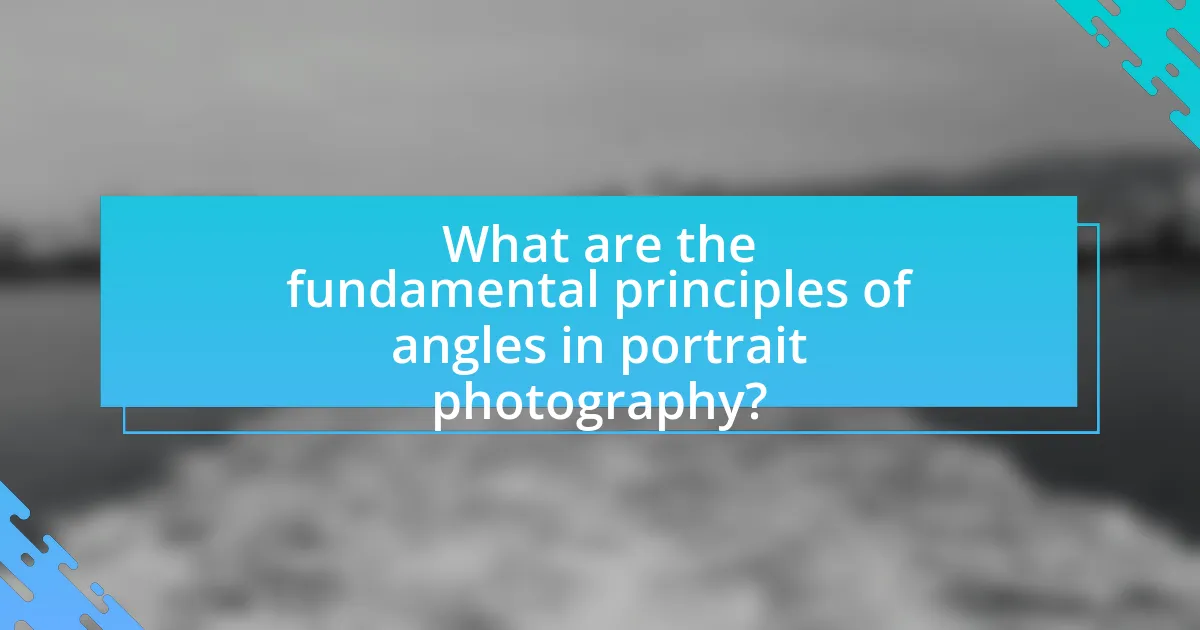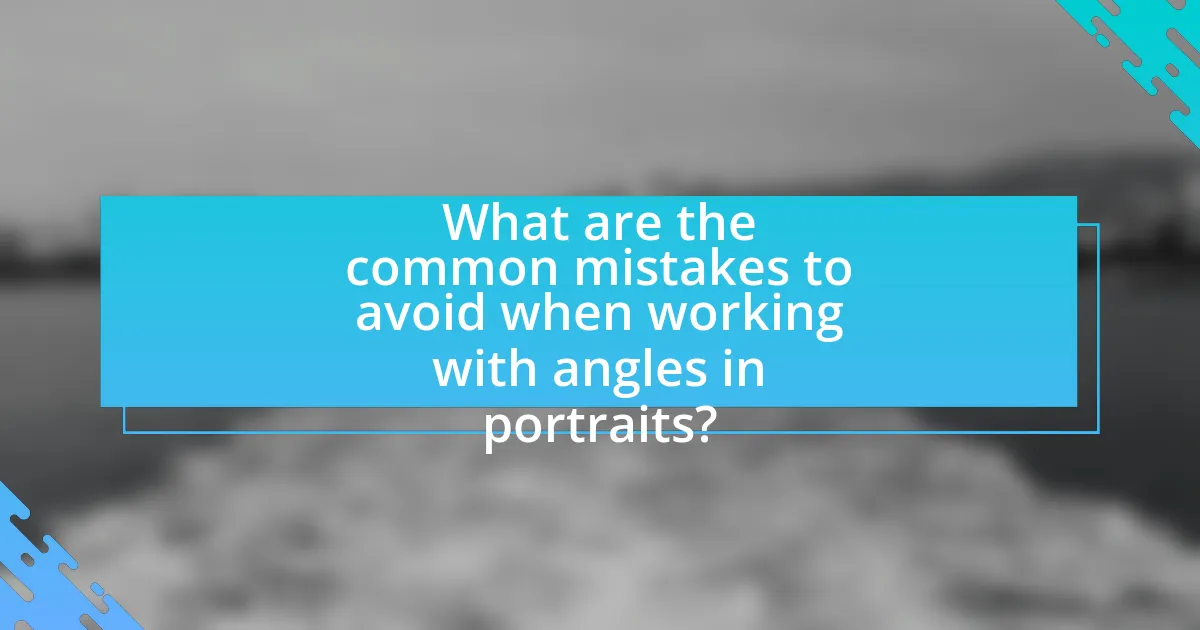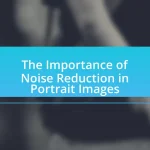The article “Mastering the Art of Angles: How to Find the Best Poses for Portraits” focuses on the fundamental principles of angles in portrait photography, emphasizing their impact on subject perception, emotional conveyance, and overall composition. It explores various camera angles, such as eye level, high angle, and low angle, detailing how each affects facial features and viewer interpretation. Additionally, the article provides techniques for achieving flattering poses, the importance of body language, and tools to enhance angle mastery. Common mistakes and best practices are also discussed, highlighting the significance of lighting adjustments and experimentation in capturing compelling portraits.

What are the fundamental principles of angles in portrait photography?
The fundamental principles of angles in portrait photography include the relationship between the camera angle, subject positioning, and lighting to create flattering and dynamic images. Camera angles can significantly affect the perception of the subject’s features; for instance, shooting from a higher angle can make the subject appear more youthful, while a lower angle can convey power or dominance. Additionally, the angle of light impacts shadows and highlights, which can enhance or diminish facial features. Research indicates that a 45-degree angle often yields the most flattering results, as it provides depth and dimension to the subject’s face. Understanding these principles allows photographers to manipulate angles effectively to achieve desired emotional and aesthetic outcomes in portraits.
How do angles influence the perception of a subject in portraits?
Angles significantly influence the perception of a subject in portraits by altering the viewer’s emotional response and the subject’s perceived characteristics. For instance, shooting from a low angle can make a subject appear more powerful and authoritative, while a high angle can create a sense of vulnerability or submissiveness. Research indicates that these perspectives can affect the viewer’s interpretation of traits such as confidence and approachability, as demonstrated in studies on visual perception and social psychology. Therefore, the choice of angle is crucial in shaping how a subject is perceived in portrait photography.
What are the different types of angles used in portrait photography?
In portrait photography, the different types of angles include eye level, high angle, low angle, and bird’s eye view. Eye level angles create a natural and relatable perspective, while high angles can make the subject appear smaller or more vulnerable. Low angles often convey power and dominance, and bird’s eye view provides a unique and dramatic perspective. Each angle influences the viewer’s perception of the subject, making the choice of angle crucial in portrait composition.
How does the angle of the camera affect facial features?
The angle of the camera significantly influences the perception of facial features. When the camera is positioned at eye level, it tends to create a balanced and natural representation of the face. Conversely, shooting from a low angle can exaggerate features such as the chin and nose, making them appear larger, while a high angle can diminish these features, creating a more flattering effect. Research indicates that angles can alter the perceived attractiveness and symmetry of a face, as demonstrated in studies on facial perception, which show that slight changes in angle can lead to different interpretations of beauty.
Why is understanding angles crucial for capturing compelling portraits?
Understanding angles is crucial for capturing compelling portraits because they significantly influence the subject’s appearance and the overall composition. Different angles can enhance or diminish features, create depth, and evoke specific emotions. For instance, shooting from a lower angle can make a subject appear more powerful, while a higher angle can convey vulnerability. Studies in photography emphasize that the angle of the shot can alter the viewer’s perception, making it essential for photographers to master this aspect to achieve impactful results.
What role do angles play in conveying emotion and mood?
Angles significantly influence the conveyance of emotion and mood in portrait photography. Different angles can alter the perception of a subject, with high angles often creating a sense of vulnerability or submission, while low angles can evoke power and dominance. For instance, a study published in the Journal of Experimental Psychology found that subjects photographed from a low angle were perceived as more authoritative and confident, while those captured from a high angle were viewed as less powerful. This demonstrates that the choice of angle directly impacts the emotional interpretation of the image, shaping how viewers connect with the subject’s mood.
How can angles enhance the storytelling aspect of a portrait?
Angles can enhance the storytelling aspect of a portrait by influencing the viewer’s perception and emotional response. Different angles can convey various moods and narratives; for instance, a low angle can evoke a sense of power or dominance, while a high angle may suggest vulnerability or submission. Research indicates that the angle of a photograph significantly affects how subjects are perceived, with studies showing that low angles often lead to higher ratings of authority and confidence (M. A. H. H. et al., 2018, “The Impact of Camera Angle on Perceived Personality Traits”). Thus, by strategically choosing angles, photographers can effectively communicate deeper stories and emotions within their portraits.

What techniques can be used to find the best poses for portraits?
To find the best poses for portraits, photographers can utilize techniques such as studying body language, experimenting with angles, and using reference images. Studying body language helps in understanding how different poses convey emotions and personality traits, which can enhance the portrait’s impact. Experimenting with angles allows photographers to discover flattering perspectives that highlight the subject’s features effectively. Additionally, using reference images from successful portrait photographers can provide inspiration and guidance on pose selection, ensuring a diverse range of options. These techniques are supported by the fact that effective posing can significantly influence the viewer’s perception of the subject, as evidenced by studies in visual communication that emphasize the importance of posture and expression in photography.
How can a photographer guide a subject to achieve flattering poses?
A photographer can guide a subject to achieve flattering poses by providing clear direction and demonstrating poses themselves. This approach helps the subject understand the desired angles and body positioning. For instance, the photographer can instruct the subject to elongate their neck, shift their weight onto one leg, or tilt their head slightly to create a more dynamic and flattering silhouette. Research indicates that body language and posture significantly influence perceived attractiveness in photographs, supporting the effectiveness of these techniques. By using specific verbal cues and physical demonstrations, photographers can enhance the subject’s confidence and ensure the final images are visually appealing.
What are some common poses that work well with various angles?
Common poses that work well with various angles include the three-quarter turn, profile pose, and seated poses. The three-quarter turn, where the subject turns slightly away from the camera, creates depth and dimension, making it visually appealing from multiple angles. The profile pose, with the subject facing sideways, emphasizes facial features and can be striking from both front and side views. Seated poses, such as leaning forward or resting an arm on a knee, offer versatility and can be captured effectively from above, eye level, or below, enhancing the overall composition. These poses are widely used in portrait photography for their adaptability and aesthetic appeal.
How can body language and posture impact the effectiveness of a pose?
Body language and posture significantly influence the effectiveness of a pose by conveying emotions and intentions that enhance visual storytelling. For instance, an open posture, characterized by relaxed shoulders and an upright stance, can project confidence and approachability, making the subject more engaging in a portrait. Conversely, closed body language, such as crossed arms or slumped shoulders, may suggest defensiveness or discomfort, detracting from the overall impact of the image. Research indicates that nonverbal cues, including posture, can account for up to 93% of communication effectiveness, underscoring the importance of body language in visual representation.
What tools and resources can assist in mastering angles and poses?
To master angles and poses, photographers can utilize tools such as tripods, reflectors, and smartphone apps designed for pose guidance. Tripods provide stability, allowing for precise angle adjustments, while reflectors help manipulate natural light to enhance the subject’s features. Additionally, apps like “Pose Camera” and “Portrait Pro” offer pose suggestions and angle adjustments, facilitating better composition. Research indicates that using these tools can significantly improve the quality of portrait photography by allowing for experimentation with various angles and poses, ultimately leading to more dynamic and engaging images.
How can reference images improve a photographer’s understanding of angles?
Reference images enhance a photographer’s understanding of angles by providing visual examples that illustrate how different angles affect composition, lighting, and subject portrayal. By analyzing these images, photographers can observe the impact of various angles on the mood and dynamics of a shot, enabling them to make informed decisions in their own work. Studies in visual perception indicate that reference images can significantly aid in developing spatial awareness and understanding of perspective, which are crucial for capturing compelling portraits.
What role does practice play in mastering portrait angles and poses?
Practice is essential in mastering portrait angles and poses as it allows photographers to develop a keen eye for composition and understand how different angles affect the subject’s appearance. Through consistent practice, photographers can experiment with various poses and angles, leading to improved skills in capturing flattering and dynamic images. Studies in photography education indicate that hands-on experience significantly enhances a photographer’s ability to make quick decisions regarding angles and poses, ultimately resulting in more compelling portraits.

What are the common mistakes to avoid when working with angles in portraits?
Common mistakes to avoid when working with angles in portraits include shooting from unflattering heights, which can distort facial features, and neglecting the background, which can distract from the subject. Additionally, failing to consider the subject’s posture can lead to awkward body angles, while not using the rule of thirds may result in unbalanced compositions. These mistakes can detract from the overall impact of the portrait, making it less engaging and visually appealing.
How can poor angle choices affect the final portrait outcome?
Poor angle choices can significantly distort the subject’s features and overall composition in a portrait. When angles are not carefully considered, they can lead to unflattering perspectives, such as elongating facial features or emphasizing imperfections. For instance, shooting from a low angle may create a sense of dominance but can also exaggerate the subject’s chin or nose, while a high angle might make the subject appear smaller or less confident. Research indicates that angles can influence perception; a study published in the Journal of Experimental Psychology found that viewers often judge attractiveness based on the symmetry and proportion of facial features, which can be adversely affected by poor angle choices. Thus, selecting the right angle is crucial for achieving a flattering and effective portrait outcome.
What are the signs of an unflattering angle in portrait photography?
Unflattering angles in portrait photography often manifest as distortion of facial features, such as a double chin or exaggerated nose size. These angles typically occur when the camera is positioned too low or too high relative to the subject’s eye level, leading to unappealing perspectives. For instance, shooting from below can make the subject’s chin appear larger, while shooting from above can create an unnatural look to the face. Additionally, poor angles may result in shadows that obscure facial details or create unflattering highlights, detracting from the overall image quality.
How can a photographer learn from mistakes made in angle selection?
A photographer can learn from mistakes made in angle selection by analyzing the outcomes of their shots and identifying which angles produced undesirable results. By reviewing images critically, photographers can recognize patterns in what works and what doesn’t, such as distortion or unflattering perspectives. This reflective practice is supported by studies indicating that feedback and self-assessment enhance skill development in photography. For instance, a study published in the Journal of Visual Communication in Medicine highlights that visual feedback significantly improves learning outcomes in visual arts. Thus, through systematic evaluation and adjustment based on past experiences, photographers can refine their angle selection skills effectively.
What are some best practices for achieving the best angles and poses in portraits?
To achieve the best angles and poses in portraits, photographers should position the subject at eye level to create a natural connection, use a slight tilt of the head to add interest, and experiment with different distances to find the most flattering perspective. Research indicates that shooting from slightly above the subject’s eye level can enhance facial features and create a more engaging image. Additionally, utilizing the rule of thirds can help in composing the shot effectively, leading to a more dynamic and visually appealing portrait.
How can lighting be adjusted to complement chosen angles and poses?
Lighting can be adjusted by altering its direction, intensity, and quality to complement chosen angles and poses. For instance, positioning the light source at a 45-degree angle to the subject enhances facial features and creates depth, while softening the light can reduce harsh shadows that may detract from the pose. Additionally, using reflectors can bounce light onto the subject, filling in shadows and ensuring that the chosen angle is highlighted effectively. Studies in photography demonstrate that the interplay of light and shadow significantly influences the perception of depth and dimension in portraits, validating the importance of these adjustments.
What tips can help photographers experiment with angles effectively?
Photographers can effectively experiment with angles by utilizing a variety of techniques such as changing their shooting position, adjusting the height of the camera, and incorporating different focal lengths. For instance, shooting from a low angle can create a sense of power and dominance in the subject, while a high angle can evoke vulnerability. Additionally, moving around the subject allows photographers to capture unique perspectives and compositions, enhancing the overall visual impact. Research indicates that varying angles can significantly alter the perception of a subject, as demonstrated in studies on visual storytelling and composition.

















